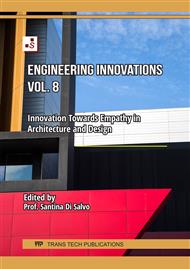[1]
Twenge, J. M. (2019). More time on technology, less happiness? Associations between digital-media use and psychological well-being. Current Directions in Psychological Science, 28(4), 372-379.
DOI: 10.1177/0963721419838244
Google Scholar
[2]
Nowland, R., Necka, E. A., & Cacioppo, J.T. (2018). Loneliness and social internet use: pathways to reconnection in a digital world?. Perspectives on Psychological Science, 13(1),70-87.
DOI: 10.1177/1745691617713052
Google Scholar
[3]
Fox, B. (2019). An Introduction to Emotions and Loneliness in a Networked Society. In Emotions and Loneliness in a Networked Society (pp.1-9). Palgrave Macmillan, Cham.
DOI: 10.1007/978-3-030-24882-6_1
Google Scholar
[4]
Nir, B., & Ariel, Y. (2019). Online Connectedness as a Cure for Loneliness?. In Emotions and Loneliness in a Networked Society (pp.271-282). Palgrave Macmillan, Cham.
DOI: 10.1007/978-3-030-24882-6_14
Google Scholar
[5]
Howes, D. (2022). The sensory studies manifesto: Tracking the sensorial revolution in the arts and human sciences. University of Toronto Press.
DOI: 10.3138/9781487528638
Google Scholar
[6]
Hemberg, J., Östman, L., Korzhina, Y., Groundstroem, H., Nyström, L., & Nyman-Kurkiala, P. (2022). Loneliness as experienced by adolescents and young adults: an explorative qualitative study. International Journal of Adolescence and Youth, 27(1), 362-384.
DOI: 10.1080/02673843.2022.2109422
Google Scholar
[7]
Walker, S. C., Trotter, P. D., Swaney, W. T., Marshall, A., & Mcglone, F. P. (2017). C-tactile afferents: Cutaneous mediators of oxytocin release during affiliative tactile interactions?. Neuropeptides, 64, 27-38.
DOI: 10.1016/j.npep.2017.01.001
Google Scholar
[8]
Kleinpeter, E. (2023). Technoscientific Materialism. In Handbook of the Anthropocene: Humans between Heritage and Future (pp.533-536). Cham: Springer International Publishing.
DOI: 10.1007/978-3-031-25910-4_84
Google Scholar
[9]
El Kiassi, J., & Jahidi, R. (2023). Technostress: A Concept Analysis. International Journal of Accounting, Finance, Auditing, Management and Economics, 4(3-1), 154-169.
Google Scholar
[10]
Mills, K. A., Unsworth, L., & Scholes, L. (2023). Literacy for digital futures: Mind, body, text (p.274). Taylor & Francis.
DOI: 10.4324/9781003137368
Google Scholar
[11]
Illich, I. (1973). Tools for Conviviality, Harper & Row , Publishers, New York, Evanston, San Francisco, London.
Google Scholar
[12]
Burckhardt, L. (1981): Design ist unsichtbar. In: Gsöllpointer, H., Hareiter, A. & Ortner, L. (Hrsg.): Design ist unsichtbar. Publikation anlässlich der Ausstellung Forum Design.
Google Scholar
[13]
Norman, D. A. (2004). Emotional design: Why we love (or hate) everyday things. Civitas Books.
Google Scholar
[14]
Bridger, D. (2017). Neuro design: Neuromarketing insights to boost engagement and profitability. Kogan Page Publishers.
Google Scholar
[15]
Rouw, R., & Scholte, H. S. (2010). Neural basis of individual differences in synesthetic experiences. Journal of Neuroscience, 30(18), 6205-6213.
DOI: 10.1523/jneurosci.3444-09.2010
Google Scholar
[16]
Leonard, D., & Rayport, J. F. (1997). Spark innovation through empathic design. Harvard business review, 75, 102-115.
Google Scholar
[17]
Star, S. L., & Griesemer, J. R. (1989). Institutional ecology,translations' and boundary objects: Amateurs and professionals in Berkeley's Museum of Vertebrate Zoology, 1907-39. Social studies of science, 19(3), 387-420.
DOI: 10.1177/030631289019003001
Google Scholar
[18]
McEwen, A., & Cassimally, H. (2013). Designing the internet of things. John Wiley & Sons.
Google Scholar
[19]
Reagle Jr, J. M. (2019). Hacking life: Systematized living and its discontents. MIT Press.
DOI: 10.7551/mitpress/11582.001.0001
Google Scholar
[20]
Picard, R. W. (2000). Affective computing. MIT press.
Google Scholar
[21]
Sagl, G., Resch, B., & Blaschke, T. (2015). Contextual sensing: Integrating contextual information with human and technical geo-sensor information for smart cities. Sensors, 15(7), 17013-17035.
DOI: 10.3390/s150717013
Google Scholar
[22]
Ballendat, T., Marquardt, N., & Greenberg, S. (2010, November). Proxemic interaction: designing for a proximity and orientation-aware environment. In ACM International Conference on Interactive Tabletops and Surfaces (pp.121-130). ACM.
DOI: 10.1145/1936652.1936676
Google Scholar
[23]
Van der Bijl-Brouwer, M., & Dorst, K. (2017). Advancing the strategic impact of human-centred design. Design Studies, 53, 1-23.
DOI: 10.1016/j.destud.2017.06.003
Google Scholar
[24]
Langella, C. (2021). Design and science: a pathway for material design. In Materials Experience 2 (pp.259-277). Butterworth-Heinemann.
Google Scholar
[25]
Rossi, G., & Scabini, E. (2013). Famiglia e nuovi media. Vita e Pensiero.
Google Scholar
[26]
van Raalte, L.J., & Floyd, K. (2020). Daily hugging predicts lower levels of two proinflammatory cytokines. Western Journal of Communication, 1-20.
DOI: 10.1080/10570314.2020.1850851
Google Scholar
[27]
La Cecla, F. (2020). Perdersi: l'uomo senza ambiente. Mimesis.
Google Scholar
[28]
Boella, L. (2010). Sentire l'altro. Raffaello Cortina Editore.
Google Scholar


